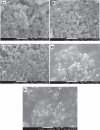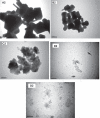High-energy ball milling technique for ZnO nanoparticles as antibacterial material
- PMID: 21720499
- PMCID: PMC3124392
- DOI: 10.2147/IJN.S18267
High-energy ball milling technique for ZnO nanoparticles as antibacterial material
Abstract
Nanoparticles of zinc oxide (ZnO) are increasingly recognized for their utility in biological applications. In this study, the high-energy ball milling (HEBM) technique was used to produce nanoparticles of ZnO from its microcrystalline powder. Four samples were ball milled for 2, 10, 20, and 50 hours, respectively. The structural and optical modifications induced in the 'as synthesized' nanomaterials were determined by X-ray diffraction (XRD), scanning electron microscopy (SEM), transmission electron microscope (TEM), and photoluminescence emission spectra (PL). SEM and TEM results show a gradual decrease in particle size from around 600 to ∼30 nm, with increased milling time. The initial microstructures had random shapes, while the final shape became quite spherical. XRD analysis showed ZnO in a hexagonal structure, broadening in the diffracted peaks and going from larger to smaller particles along with a relaxation in the lattice constant c. The value of c was found to increase from 5.204 to 5.217 Å with a decrease in particle size (600 to ∼30 nm). PL result showed a new band at around 365 nm, whose intensity is found to increase as the particles size decreases. These remarkable structural and optical modifications induced in ZnO nanoparticles might prove useful for various applications. The increase in c value is an important factor for increasing the antibacterial effects of ZnO, suggesting that the HEBM technique is quite suitable for producing these nanoparticles for this purpose.
Keywords: HEBM; SEM; XRD; ZnO nanoparticles; antibacterial; photoluminescence.
Figures







References
-
- Puckett SD, Taylor E, Raimondo T, et al. The relationship between the nanostructure of titanium surfaces and bacterial attachment. Biomaterials. 2010;31:706–713. - PubMed
-
- Seo WS, Lee JH, Sun X, et al. FeCo/graphitic shell nanocrystals as advanced magnetic-resonance-imaging and near infrared agents. Nat Mater. 2006;5(12):971–976. - PubMed
-
- Dilnawaz F, Singh A, Mohanty C, Sahoo SK. Dual drug loaded super-paramagnetic iron oxide nanoparticles for targeted cancer therapy. Biomaterials. 2010;3:3694–3706. - PubMed
-
- Chen Z, Shan Z, Cao MS, et al. Zinc oxide nanotetrapods. Nanotechnology. 2004;15:365.
-
- Wu J, Xie CS, Bai ZK, et al. Preparation of ZnO-glass varistor from tetrapod ZnO nanopowders. Mater Sci Eng B. 2002;95:157–161.
Publication types
MeSH terms
Substances
LinkOut - more resources
Full Text Sources
Medical

